Leather is a luxurious material that can last for years with proper care. When it starts to look a bit tired, you might be wondering whether to use leather stain or leather dye. Both have their pros and cons, so how do you decide which is the best option for your furniture? In this article, we will discuss the differences between leather stain and dye, as well as provide some tips on how to choose the right one for your needs.
What is Leather Dye and How It’s Used
Leather dye is a type of coloring agent that penetrates the deepest parts of the leather to change its color. It’s usually applied with a sponge or brush, and when it’s dry, the new color is permanent.
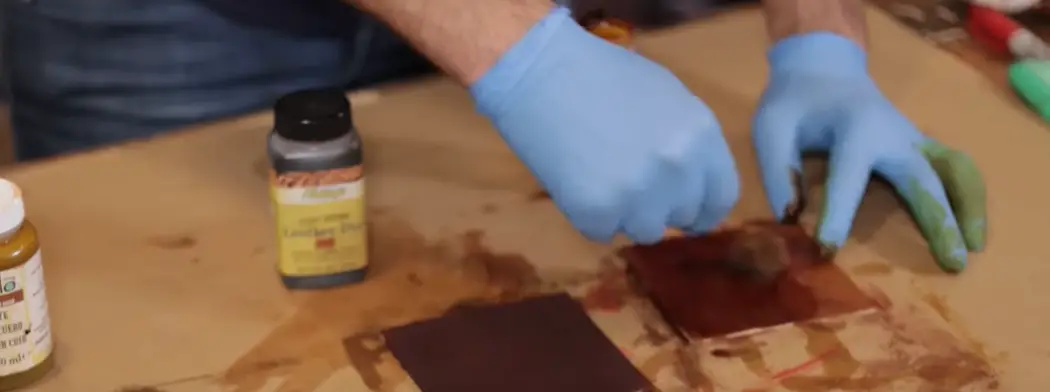
Dye can be used to darken leather or change its color completely. It’s a good choice if you want to evenly color large areas or achieve very specific colors.
Dye can also be used to refresh faded areas or worn spots on your furniture. Simply apply dye over the existing color – it will penetrate and adhere to the existing finish, resulting in an even, refreshed appearance.
If you want to experiment with different colors or achieve a two-tone look, you can combine dyes to create custom colors. Just be sure to test your color combination on a scrap piece of leather before applying it to your furniture.
The huge advantage of dyes is that they won’t ruin the grain of your leather like stains will. Dye leaves the leather looking natural, just a different color.
Unlike stains however, dyes may require several coats to achieve the desired color. And they can be difficult to remove if you’re not happy with the results. Dyes penetrate the deepest layer of the leather, so they’re not ideal if you want a temporary change or plan to refinish your furniture in the future.
Dyes can also require more time to dry, so be sure to follow the manufacturer’s instructions carefully. If you don’t allow enough time for the dye to dry completely, it can rub off on your clothes or transfer to other surfaces.
It’s also worth mentioning that some dyes are not compatible with all types of leather. Vinyl or faux leather should not be dyed because the dye will not adhere properly and may even damage the surface.
Types of Leather Dye
Different types of leather dyes exist on the market, and each has its own specific purpose. Let’s discuss the main types of leather dyes you might encounter.
Alcohol-based
Also known as spirit-based or aniline dyes, these are the most commonly used dyes for leather furniture. They penetrate the surface of the leather to change its color and usually come in a spray bottle or pump top for easy application.
Alcohol-based dyes are available in a wide range of colors, so you’re sure to find one that meets your needs. Just be aware that since they penetrate the leather, alcohol-based dyes can sometimes darken the leather more than you intended. If you’re looking to achieve a very specific color, it’s best to test the dye on a scrap piece of leather before applying it to your furniture.
The main downside of alcohol-based dyes is that they may be too harsh for some types of leather. If you’re not sure if your furniture is made with a type of leather that can handle an alcohol-based dye, it’s best to consult a professional before proceeding.
Water-based
Water-based leather dyes are some of the most popular and commonly used dyes. As the name suggests, these dyes use water as their main solvent. Water-based leather dyes are perfect for those who want an easy-to-use dye that will yield great results.
Oil-based
This type of leather dye is ideal for use on unfinished or uncoated leather. It penetrates the hide deeply, resulting in a long-lasting and natural-looking finish. With oil-based dyes you won’t have to worry about your leather becoming too stiff or brittle over time.
Another advantage of oil-based leather dyes is that they can provide a richer color than water-based dyes. If you’re looking for a deeper and more vibrant color, oil-based dyes are the way to go.
The main downside of oil-based leather dyes is that they can be more difficult to work with. They can be messy and smelly, and they require more time to dry. You’ll also need to take extra care when applying them, as they can easily stain your clothes or furniture. [1], [2], [3], [4]
What is Leather Stain and How It’s Used
Leather stain is similar to dye, in that it’s a coloring agent that penetrates the surface of the leather. However, unlike dye, stain penetrates only the top layer of leather. This makes stain a good choice if you want to achieve a richer, deeper color or match the existing color of your furniture. Stains provide a much richer color than dyes which can often appear muted.
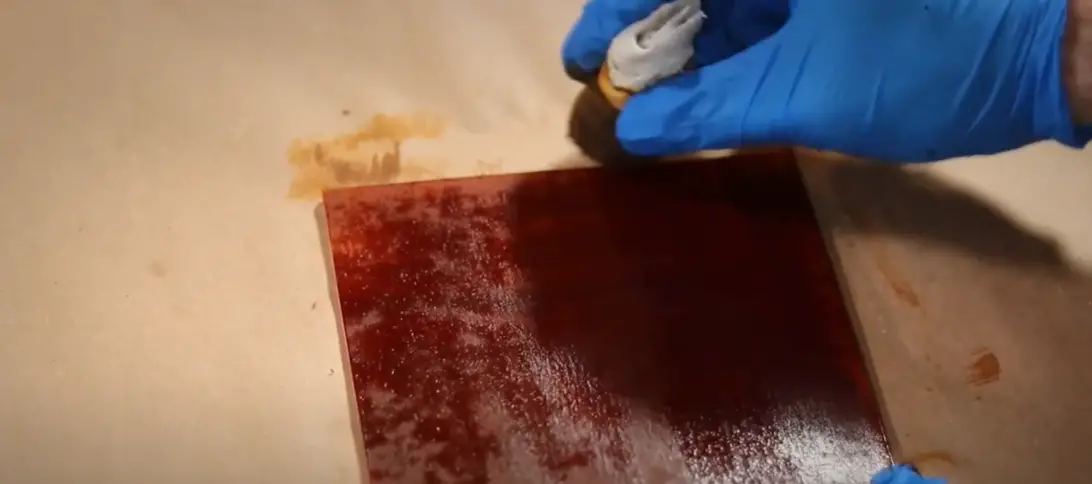
Once it dries, the color will remain until it’s removed with another cleaning product or by simply allowing it to fade over time with extended exposure to sunlight and air.
Stains can also be used to add shading and depth to an existing color, or to create an antiqued look by adding darker shades around the edges and in creases. Sometimes they can even mimic the patina that develops on well-worn leather over time.
Unlike leather dyes, stains typically don’t require a topcoat or sealer once they’re dry. However, you may want to apply one if you’re concerned about the stain rubbing off onto clothing or upholstery. For example, many people decide to apply a clear coat to protect the leather and keep it from staining.
Leather stains are also much faster to dry than dyes, so you won’t have to wait as long before using the furniture or item again.
One negative of leather stains, is that they tend to wear down much faster than dyes and will need to be re-applied more often to maintain the original look. And certain stains can hide or distort the grain pattern of the leather, making it appear dull.
Types of Leather Stains
Just like there are many different types of leather, there are also many different types of stains available to choose from. Let’s discuss them!
Liquid leather stains
As the name suggests, liquid leather stains come in a water solution. They are the most common type of stain used on leather and are typically easy to apply. One of the main benefits of liquid stains is that they are rather easy to spread, however they can also be difficult to control.
Application wise, liquid leather stains are very similar to leather dyes. You will want to use a clean, lint-free cloth to apply the stain evenly across the surface of your leather. Once you have applied the stain, you will need to allow it to dry completely before moving on to the next step in your project.
Gel leather stains
Gel leather stains are similar to liquid stains in both their composition and application. However, they tend to be a bit thicker and more viscous than their liquid counterparts. This can make them slightly more difficult to apply evenly, but it also means they are less likely to run or drip during the staining process.
You will also need to remove the excess stain from your leather after application, as it can dry hard and become difficult to remove later on. [1], [2], [5]
Tips on How to Apply Leather Dye
Whether you’re using a leather dye or a leather stain, the application process is pretty much the same. But there are some key things you need to know before you start regardless. Let’s discuss them.
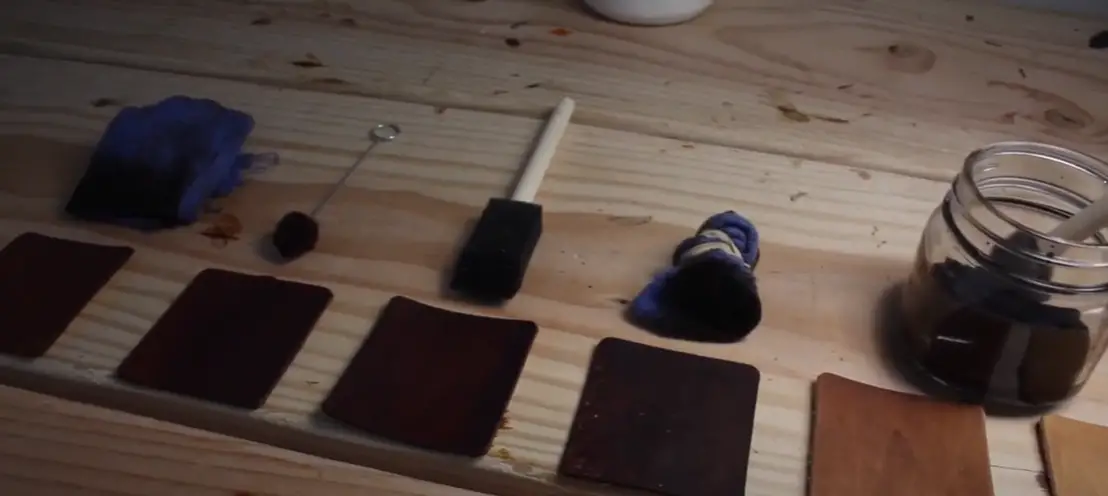
Select the dying stage beforehand
You can actually choose to dye your leather at any stage of the tanning process, but it’s important that you know which stage you’re dying at beforehand.
One option you have is to dye your leather before cutting and shaping it. This is the best option if you’re looking to achieve an even and consistent color. Dying your leather after it’s been cut and shaped is another option, but this can result in a more mottled and uneven finish.
Always test the dye or stain before proceeding with coloring
This is critical. You need to make sure that the leather you are using will accept the color. The last thing you want is to put all that work in, only to have the color not take or be very light.
To test, get a cotton swab and apply a generous amount of dye or stain to it. Rub it into a small inconspicuous area of the leather. Wait at least 24 hours to see how the color looks and feels before proceeding.
Consider deep dyeing
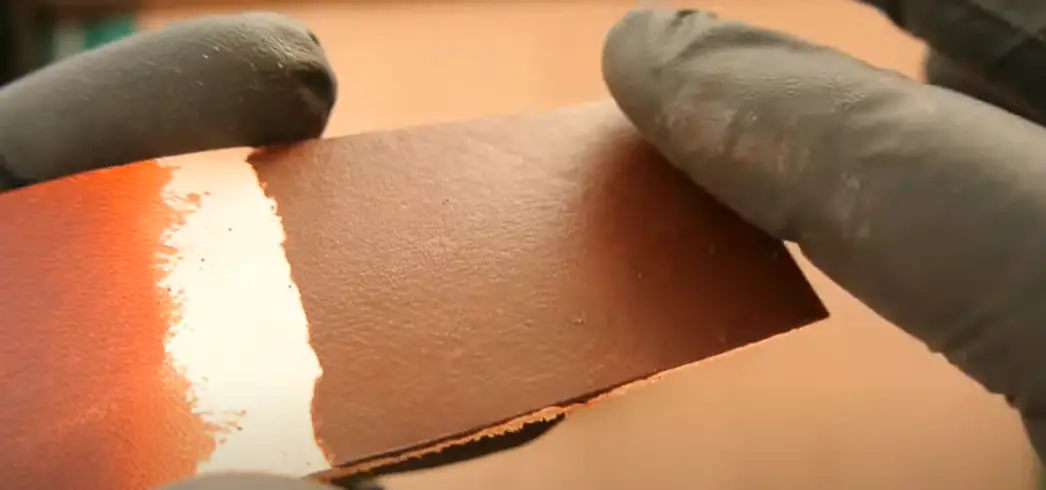
If you have a piece of leather furniture that’s starting to show its age, you may be wondering if you should dye or stain it. However the most effective method that dyes the entire piece of leather is called deep dyeing.
Deep dyeing is the process of coloring leather so that the color penetrates deeply into the hide. This is different from surface treatments like stains and finishes, which simply coat the leather’s surface.
Dyeing leather is a complex process that requires knowledge of both chemistry and tanning. Leather dyers use a variety of chemicals to change the pH of the leather and open up the fibers so that color can be absorbed more deeply.
It’s also important to note that because the dye penetrates so deeply, it can change the color of the leather significantly. So if you’re considering this method, make sure you pick a color you’re absolutely in love with!
Clean the leather beforehand
You need to make sure the leather is clean before you start. Otherwise, the dye or stain will not adhere properly and your results will be disappointing.
To clean the leather, start by vacuuming it with a soft brush attachment. Then wipe it down with a damp cloth. If there are any stubborn stains, you can use a mild leather cleaner. Just be sure to test it in an inconspicuous spot first to make sure it won’t damage the leather.
Let the leather dry completely before you move on to the next step. Do not use a hairdryer or any other kind of direct heat to speed up the process.
Apply neatsfoot oil
Before you start dyeing or staining your leather, you may want to apply neatsfoot oil. Neatsfoot oil is a natural lubricant that is derived from the feet of cows. It is used to protect and condition leather, as well as to darken it. Neatsfoot oil can be applied directly to the leather, or it can be diluted with water or another solvent. Applying it will help the leather absorb the color better and ensure an even finish.
To apply, simply rub a small amount of oil into the leather with a clean cloth. You don’t need to saturate the leather, just make sure it’s evenly coated. Then, let the oil soak in for at least 30 minutes before proceeding.
Don’t trust the charts too much
As you may know, there are many different kinds of leather, and each one takes dye or stain differently. This is why you’ll see a lot of “conversion charts” online that show you what colors will result from using a certain dye or stain on a certain kind of leather.
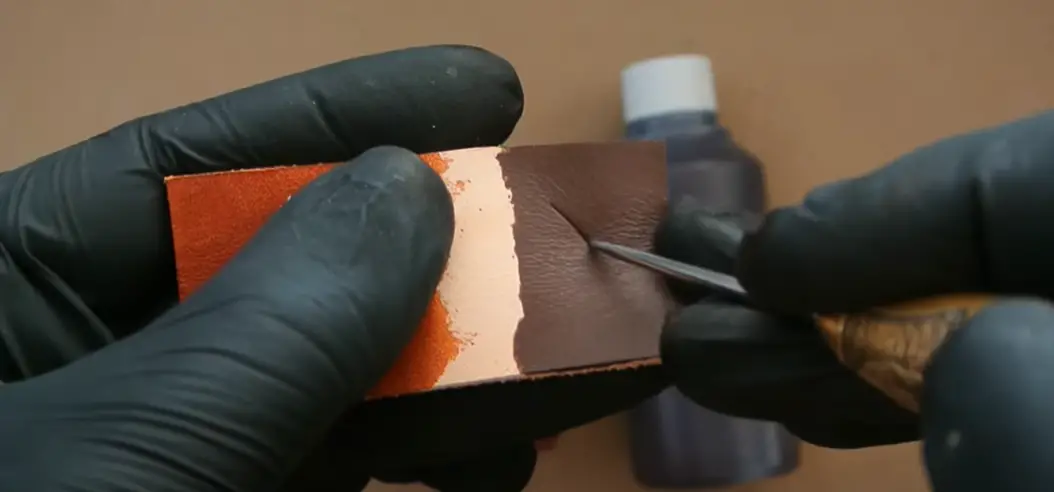
Be prepared to apply multiple coats
Leather dyes and stains are very different when it comes to how they look on leather. A leather dye will soak into the pores of the leather and change the color from the inside out. This usually results in a more even, consistent color change.
However, to get the right color, you often need to apply multiple coats of dye. The first coat will usually be very light, and each subsequent coat will get progressively darker or more brighter.
Apply paint or stain coats in circles
Another reason to use multiple coats is that leather dyes and stains can look very different when applied in different directions. For example, if you’re using a dark stain, you may find that it looks patchy if you apply it in long strokes. This is because the dye or stain will soak into the leather more in some areas than others.
To avoid this, it’s best to apply the dye or stain in circular motions. This will help ensure that the color is evenly distributed. And when applying a second coat, move in the different direction (i.e. if you went clockwise the first time, go counterclockwise the second time).
Apply finish
After you’ve applied the dye or stain to your leather item, you’ll need to protect it with a finish. This will help the color hold up over time and keep your leather looking its best. Both leather dyes and stains are susceptible to fading and wear, so a good finish is essential.
There are a few different types of finishes you can use on leather, but the most common is called a sealer. A sealer is a clear coating that goes over the dyed or stained surface and helps to protect it from wear and tear. You can find sealers at most hardware stores or online.
Applying a sealer is pretty simple. Just make sure your leather item is clean and dry, then apply a thin layer of sealer evenly over the surface. Let it dry completely before using your item again.
Be patient
Dyeing or staining leather is not a quick process. In fact, it can take several hours (or even days) to get the results you want. So it’s important to be patient and take your time. [1], [6]
FAQ
What is the best leather paint?
There are a lot of different leather paints on the market, and it can be tough to decide which one is right for your project. Here are a few things to keep in mind when choosing a leather paint:
Paints come in a variety of finishes, from glossy to matte. Consider what look you’re going for before making a purchase.
Some paints are specifically designed for use on furniture, while others are better suited for clothing or other items. Make sure you get the right type of paint for your project.
It’s important to choose a paint that is compatible with the type of leather you’re working with. Some paints work better on synthetic leathers, while others are designed for natural leathers.
When in doubt, always test the paint on a small area of the leather before applying it to the entire piece. This will help you make sure that the paint is the right color and consistency, and that it adheres well to the leather.
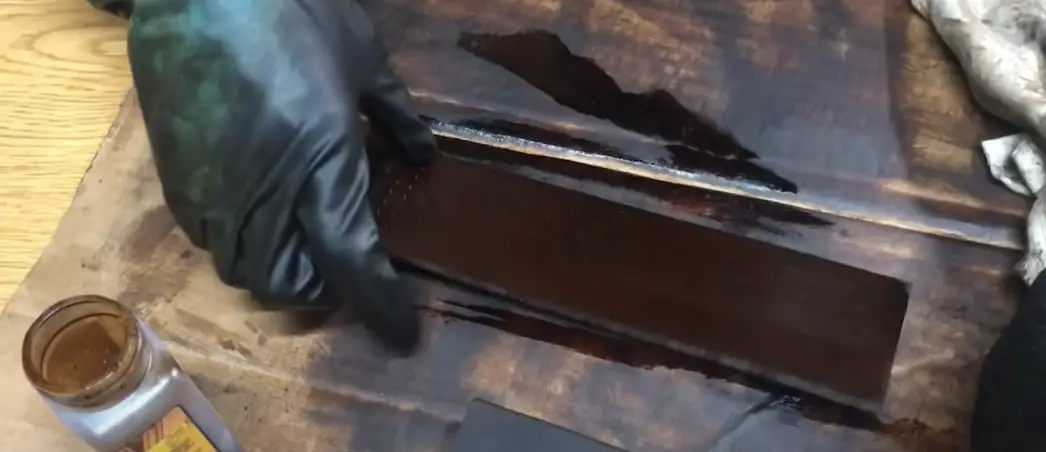
What is the difference between leather dye and stain?
Leather dye is a coloring agent that penetrates the surface of the leather and permanently changes the color. Once applied, the only way to remove it is with professional help.
Leather stain, on the other hand, does not penetrate as deeply into the leather surface. It simply coats the surface, much like paint would. This means that it’s much easier to remove if you’re not happy with the results.
So, if you’re looking for a more permanent solution, go with leather dye. If you want something that’s easier to change down the road, opt for leather stain.
Can I use stains to dye leather?
No, you cannot use stains to dye leather. Dye is a type of pigment that penetrates the surface of the leather, whereas stains sit on top of the leather.
While you might be able to find a stain that is a similar color to the dye you want to use, it will not give you the same results. The color of the stain will eventually wear off, leaving your leather looking faded and worn.
Dye, on the other hand, will penetrate the surface of the leather and become part of the material itself. This means that the color will last much longer and resist fading better than a stain would.
Is leather paint the same as leather dye?
Leather paint and leather dye are not the same. While both can be used to change the color of leather, they have different properties and will produce different results.
Leather paint is a type of coating that sits on top of the leather. It does not penetrate into the leather like a dye, so it will not change the color of the leather permanently. Instead, it will form a layer on top of the leather that can chip, crack, or peel over time. Leather paint is also more difficult to apply evenly, so it is more likely to produce an uneven finish.
On the other hand, leather dye penetrates into the leather and permanently (or long-term) changes the color. This makes it a better choice if you want a durable, long-lasting finish. Leather dye is also generally more flexible than paint, so it is less likely to crack or peel over time.
Useful Video: How To Dye Leather With Water Based Dye
Conclusion
When it comes to changing the color of your leather furniture, you have two main options: leather stain and leather dye. You may be wondering what the difference is between the two, and which is right for your needs.
While they are similar in some ways, there are also important differences to consider. In general, leather dye will provide a more long-term and consistent color change, while leather stain can be more easily removed if you decide you don’t like the new color.
Leather dyes however will take a longer time to dry, and can be more difficult to apply evenly. On other hand, leather stains penetrate only the top layer of the leather, so they will not last as long as a dye. And staining can also distort the grain pattern of the leather.
So, which should you choose? It really depends on your personal preferences and needs. Both products have their pros and cons, so it’s important to take the time to choose the right one for your project. With this guide, you should now have all the information you need to make an informed decision. Thanks for reading!
References
- https://favoredleather.com/leather-dye-vrs-stain/
- https://leatherworker.net/forum/topic/34680-dye-vs-stain/
- https://rubnrestore.com/how-to/leather-dye-vs-leather-paint/
- https://blog.leatheredgepaint.com/do-you-know-the-difference-between-leather-dye-and-leather-paint
- https://www.libertyleathergoods.com/leather-stain/
- https://www.goldbarkleather.com/sourceblog/a-basic-guide-to-dyeing-leather

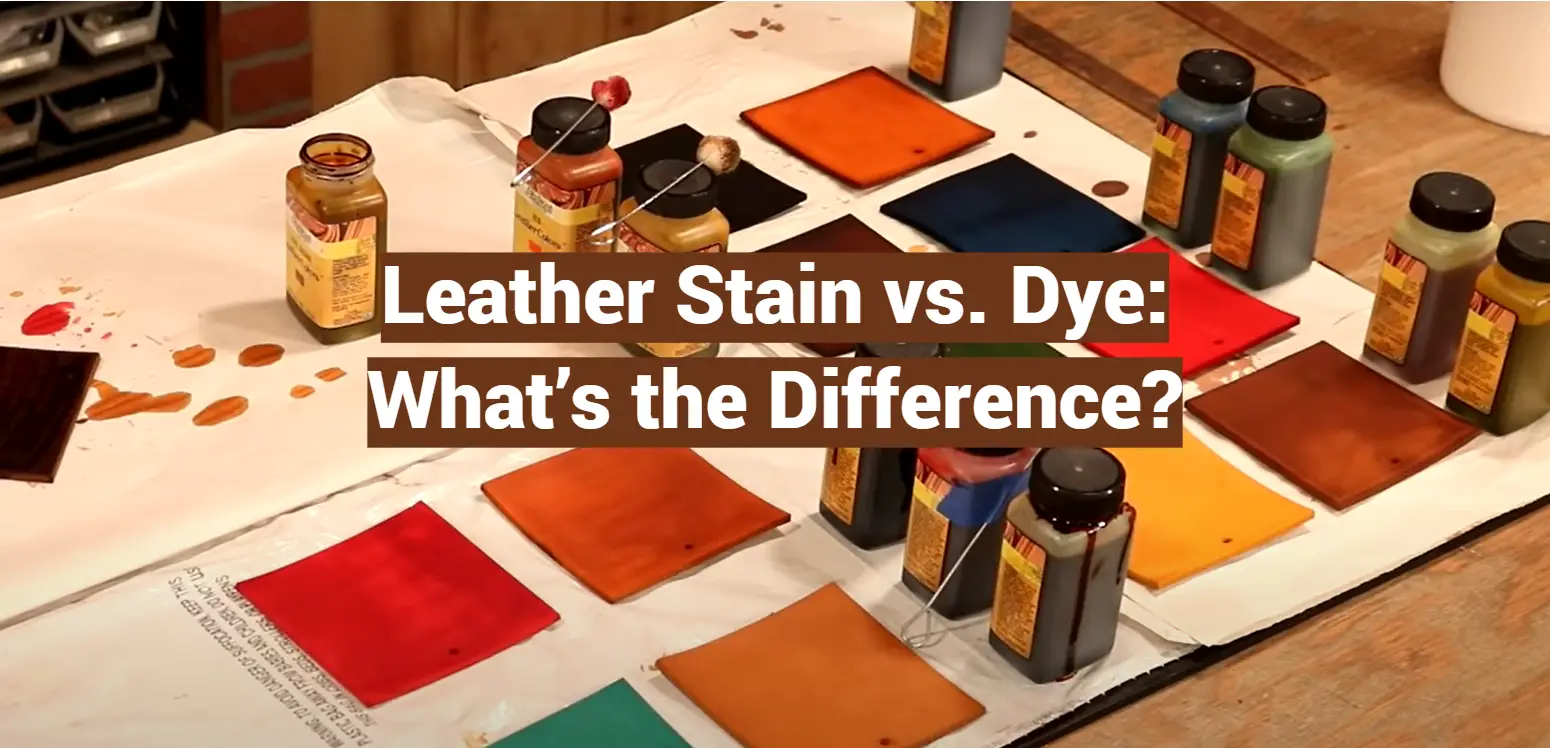





Leave a Reply